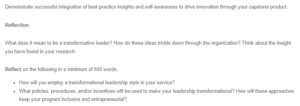Leading The Organization Through Change Reflection
Employing a Transformational Leadership Style in My Service
The implemented management and education program for heart disease utilizing mHealth technologies is innovative and transformative. It changes health monitoring, data collection, care delivery, and how patients, the population, and healthcare workers (HCWs) connect. I will employ the transformational leadership style to manage these transformations and changes as they occur. Firstly, I will focus on inspiring and motivating the users of the services, including the clients, patients, and healthcare workers. Inspirational motivation involves having a clear vision (Collins et al., 2020). I will clearly communicate the program’s vision, which focuses on managing heart disease among current patients and on improving the health of the entire community. The community will also be allowed to contribute to shaping the vision of the program.
As a transformational leader, I will focus on promoting creativity that goes beyond conventional practices. All users and HCWs will be exposed to opportunities that are intellectually stimulating. I will create an environment for continuous learning to improve heart and general health outcomes, including quizzes, skill challenges, and new challenges, and I will require users to bring forward new ideas to improve the program. Notably, one role of transformational leadership is to employ strategies that improve the competency of the team for better productivity (Bin Atan & Mahmood, 2019).
I will also employ a transformational leadership style through individualizing support and idealizing influence. Individualized support is provided based on specific user needs. Support will be user-centered. This is good for creating connections with the program and personalized experiences. On the other hand, idealized influence to encourage people to adopt and sustain the transformations and the changes the program brings in healthcare delivery will be through role modeling. In this case, together with the HCWs’ team, I will personally adopt and commit to healthy lifestyles through the program.
Policies, Procedures, and/or Incentives for Transformational Leadership
Transformation faces a challenge of resistance to change among the main population groups that the change or transformation affects. Several procedures and incentives will be employed to transform the leadership, effectively manage the change, and improve acceptance of the program. Firstly, under transformational leadership, the program will be aligned with the ethical principles in nursing, including patient autonomy, user data confidentiality, and privacy, security of users, and fair access to the program. As a transformational leader, I will promote interactions and communications that are open, honest, inspiring, and respectful of the views, ideas, and judgment of every user. To make the leadership more transformational, the focus will be engaging all users in a way that promotes participation in the program, supports new ideas to improve the program, and allows professionally supported self-paced progress through the program and individually set goals. Various incentives, including bonuses and money-back rewards for purchases and completion of challenges within the app, will be provided to promote adoption of and engagement in the program.
Keeping the Program Inclusive and Entrepreneurial
Keeping the program inclusive and entrepreneurial is required to ensure its success. Inclusivity will be ensured by adapting a program design and heart health care practices that are culturally sensitive. This is because the program and services target a wider and more diverse population beyond the local community. Cultural sensitivity is essential in healthcare communication, especially when diverse groups are involved, and is associated with positive experiences and working relationships (Brooks et al., 2019). The entrepreneurial spirit will be ensured by promoting innovativeness among the users and encouraging them to try new behavioral changes and practices that improve their overall health.
References
Bin Atan, J., & Mahmood, N. H. N. (2019). The role of transformational leadership style in enhancing employees’ competency for organization performance. Management Science Letters, 9(Special Issue 13), 2191–2200. https://doi.org/10.5267/J.MSL.2019.7.033
Brooks, L. A., Manias, E., & Bloomer, M. J. (2019). Culturally sensitive communication in healthcare: A concept analysis. Collegian, 26(3), 383–391. https://doi.org/10.1016/J.COLEGN.2018.09.007
Collins, E., Owen, P., Digan, J., & Dunn, F. (2020). Applying transformational leadership in nursing practice. Nursing Standard (Royal College of Nursing (Great Britain): 1987), 35(5), 59–66. https://doi.org/10.7748/NS.2019.E11408
ORDER A PLAGIARISM-FREE PAPER HERE
We’ll write everything from scratch
Question

Leading The Organization Through Change Reflection
Demonstrate successful integration of best practice insights and self-awareness to drive innovation through your capstone product.
Reflection
What does it mean to be a transformative leader? How do these ideas trickle down through the organization? Think about the insight you have found in your research.
Reflect on the following in a minimum of 500 words:
- How will you employ a transformational leadership style in your service?
- What policies, procedures, and/or incentives will be used to make your leadership transformational? How will these approaches keep your program inclusive and entrepreneurial?


